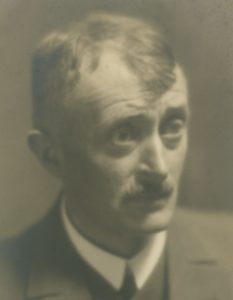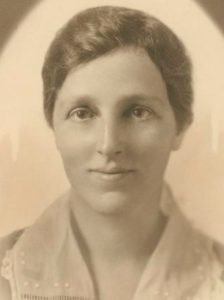John Masefield’s Letters to Litchfield
By Barbara Potter, Litchfield Historical Society
The first of his mid-April letters to Dorothy Bull (1888-1934), on April 20, 1917, was a sad and simple plea for more letters. Brief, mournful, to the point.
The second, penned some 24 hours later, is John Masefield’s (1878-1967) enthusiastic reply to Bull’s latest letter. The reply conveys his elation but is stuffed with starched enthusiasm and jaunty catchphrases prompting questions to fly from the folder in which both letters sit, washed up into their jarring juxtaposition.

English: John Masefield (1878-1967) Portrait by Mary Dale Clarke
The juxtaposition seems important. We just aren’t sure why. We, at the Litchfield Historical Society, don’t even know questions to ask. So will share what little we know follow it with a future post.
John Masefield wrote Dorothy Bull at least 94 times. Masefield wrote a 95th letter to her brother after his return from Australia, in 1935. In that letter Masefield echoed sentiments shared by locals at Bull’s death a year earlier. She was a good person, they said without exception. Of all Masefield letters to Dorothy Bull, his ‘line’ of the 20th of April is singularly, palpably sad. Like an exclamation point that leaps off of a page.
Masefield expressed the same sadness to other, more important correspondents while conducting his unpaid research on the Somme’s battlefields in the spring of 1917.
Foremost among them was Masefield’s wife Constance (Letters from the Front: 1915-1917, Peter Vansittart, 1984). Masefield wrote her almost daily. He wrote detailed, reports about the war’s progress, war crimes, field actions, conditions and fortifications, and the remains strewn across battlefields all along the Somme’s war zone. These letters appear to have been written without a shred of self-censorship and little or no B.E.F. Field Censor filtering. But then these were the letters of an Englishman to his English wife. Relative to Masefield’s Anglo-American letters of the same period there seems to be no comparison in terms of candor and content.
Masefield also wrote to Florence Corliss from the Somme. He wrote the American heiress, and wife of prominent American banker Thomas William Lamont, nearly 2,200 times between 1916 and 1952. At the beginning of April 1917, Masefield noted, to his wife Constance, that Florence Lamont “surpasses herself” by sharing her knowledge about the United States’ declaration of war. For this or, perhaps, for other reasons, Masefield’s letters to Lamont may have undergone lighter international censorship than letters to other Americans such as Bull.
But we just can’t know.
What we do know is that Masefield’s April 20th letter to Bull conveys a sadness nowhere else so clearly expressed in this Collection. And it is a letter written one day apart from the letter bearing Masefield’s great (most brittle?) good cheer.
So we’re left wondering what happened in Masefield’s mind during this period. Was he trying to paper over impressions expressed to Bull the preceding day? Was he self-censoring his thoughts so assiduously they would sail past the toughest B.E.F. Field Censors with the pace of a military march?
We don’t know.

American: Dorothy Bull (1888-1934)
Bull wouldn’t see Masefield until the following winter, when he came to lecture across the U.S. and visit U.S. military camps with recruits preparing for war. But it seems quite possible that, in 1918, the failed debutante and aspiring writer reframed her probing questions for England’s successful poet and battlefield chronicler.
We wish we knew the whereabouts of Bull’s letters to Masefield.
But we don’t.
They might have answered some of our questions. But they might not.
Perhaps all of them went the way of the wind in the stretch of time when many Masefield papers came to special collections at Harvard and Columbia. Perhaps not.
In any event, we all feel privileged for the tiny peek Dorothy Bull and her family gave us…into the mind of an Englishman with courage enough to explore a real waste land four or five years before T.S. Eliot penned the immortal opening lines of his 1922 poem: “April is the cruellest month.”
The finding aid for this collection is a work in progress. You may view it here. We are also working to digitize the collection and will let you know when the images are available in the Connecticut Digital Archives.